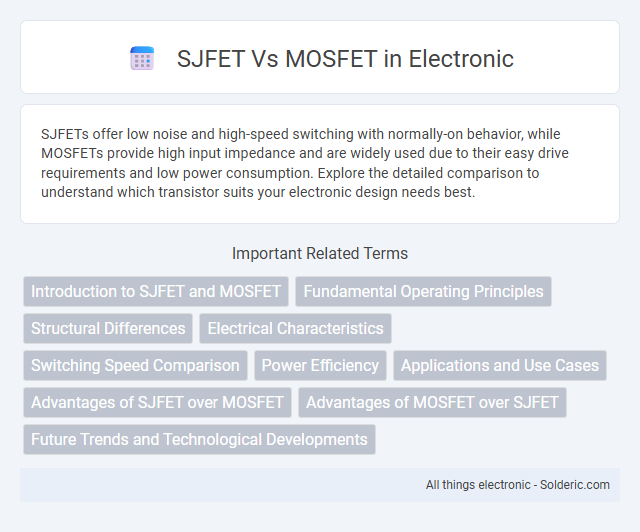SJFETs offer low noise and high-speed switching with normally-on behavior, while MOSFETs provide high input impedance and are widely used due to their easy drive requirements and low power consumption. Explore the detailed comparison to understand which transistor suits your electronic design needs best.
Comparison Table
| Feature | SJFET (Static Junction Field Effect Transistor) | MOSFET (Metal-Oxide-Semiconductor FET) |
|---|---|---|
| Structure | Junction gate with PN junction | Metal gate insulated by oxide layer |
| Gate Control | Voltage controls depletion region | Voltage controls capacitor-like gate |
| Input Impedance | Moderate (10^7 to 10^9 O) | Very High (10^12 to 10^15 O) |
| Noise Level | Lower noise | Higher noise due to oxide traps |
| Switching Speed | Slower compared to MOSFET | Faster switching performance |
| Thermal Stability | Better stability | Less stable, sensitive to temperature |
| Fabrication Complexity | Simple process | Complex, requires oxide layer |
| Applications | Low noise amplifiers, analog circuits | Digital circuits, power switching, RF amplifiers |
| Cost | Lower cost | Higher cost due to fabrication |
Introduction to SJFET and MOSFET
SJFET (Static Junction Field Effect Transistor) and MOSFET (Metal-Oxide-Semiconductor Field Effect Transistor) are two primary types of field-effect transistors used in electronic circuits. SJFET operates with a reverse-biased p-n junction to control current flow, offering low noise and high input impedance, ideal for analog applications. Your choice between SJFET and MOSFET depends on factors like switching speed, input impedance, and power efficiency in specific electronic designs.
Fundamental Operating Principles
SJFETs operate using a reverse-biased p-n junction to control current flow through a semiconductor channel, relying on gate voltage to modulate channel conductivity without the need for gate current. MOSFETs utilize an insulated gate electrode to create an electric field, inducing a conductive channel in a semiconductor material, enabling high input impedance and low power consumption. Your choice between SJFET and MOSFET depends on the required switching speed, input impedance, and power efficiency in your application.
Structural Differences
SJFETs (Static Junction Field-Effect Transistors) have a simple structure with a pn-junction gate controlling the current flow, whereas MOSFETs (Metal-Oxide-Semiconductor Field-Effect Transistors) feature an insulated gate separated from the channel by a thin oxide layer. The absence of an oxide layer in SJFETs results in lower gate leakage current compared to MOSFETs, which rely on the oxide's insulating properties to control channel conductivity. Understanding these structural differences helps you select the appropriate transistor type based on switching speed, power consumption, and noise sensitivity.
Electrical Characteristics
SJFETs (Static Junction Field Effect Transistors) exhibit low noise, high input impedance, and robust thermal stability, making them ideal for analog signal amplification and low-power applications. MOSFETs (Metal-Oxide-Semiconductor FETs) offer higher switching speeds, lower on-resistance, and better scalability in digital circuits, thanks to their insulated gate structure. When optimizing your circuit for power efficiency and speed, MOSFETs typically outperform SJFETs in high-frequency switching, while SJFETs excel in linear and low-noise environments.
Switching Speed Comparison
SJFETs (Static Junction Field-Effect Transistors) exhibit faster switching speeds than MOSFETs (Metal-Oxide-Semiconductor Field-Effect Transistors) due to their majority carrier operation and absence of gate oxide, resulting in lower gate capacitance and reduced delay times. MOSFETs, however, often face slower switching caused by gate oxide charging and higher input capacitances that limit high-frequency performance. In high-speed switching applications, SJFETs offer superior efficiency and reduced power loss, making them preferable for RF and analog circuits.
Power Efficiency
SJFET (Static Junction Field Effect Transistor) offers higher power efficiency than MOSFET (Metal-Oxide-Semiconductor FET) in low-noise, low-power amplification applications due to its lower gate leakage current. MOSFETs excel in high-frequency and high-speed switching but suffer from higher gate capacitance causing greater power dissipation. Choosing SJFET over MOSFET improves power efficiency in sensitive analog circuits by minimizing off-state leakage and reducing thermal losses.
Applications and Use Cases
SJFETs excel in low-noise analog signal amplification and RF applications due to their high input impedance and low flicker noise, making them ideal for sensitive sensor interfaces and audio preamplifiers. MOSFETs dominate power electronics, digital circuits, and switching applications thanks to their fast switching speeds, high input impedance, and scalability in integrated circuits, widely used in microprocessors, power supplies, and motor controllers. Your choice between SJFET and MOSFET depends on whether you prioritize low-noise analog performance or efficient high-speed switching in your electronic design.
Advantages of SJFET over MOSFET
SJFETs offer superior noise performance and faster switching speeds compared to MOSFETs, making them ideal for high-frequency applications. Their simpler construction results in higher reliability and better thermal stability, enhancing your circuit's overall durability in harsh environments. SJFETs also typically consume less power during operation due to their normally-on characteristic, which is advantageous in low-power designs.
Advantages of MOSFET over SJFET
MOSFETs offer higher input impedance and faster switching speeds compared to SJFETs, making them ideal for high-frequency applications. Their voltage-driven operation results in lower power consumption and easier integration into digital circuits. Additionally, MOSFETs provide better scalability and are widely available in various configurations, enhancing design flexibility.
Future Trends and Technological Developments
SJFET technology is evolving to offer lower noise figures and improved high-frequency performance, making it increasingly suitable for specialized analog and RF applications. MOSFETs continue to dominate with advancements in power efficiency, scaling, and integration for digital and power electronics, driven by innovations such as FinFET and gate-all-around (GAA) transistors. Emerging materials like gallium nitride (GaN) and silicon carbide (SiC) are shaping the future of both SJFET and MOSFET devices by enhancing thermal stability and switching speeds in power electronics.
SJFET vs MOSFET Infographic

 solderic.com
solderic.com